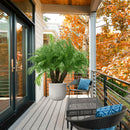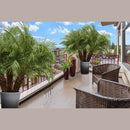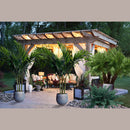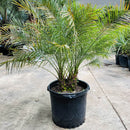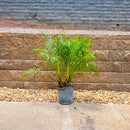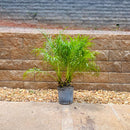| Grows Well In Zones: | 4-11 Patio / 10-11 Outdoors |
| Mature Height: |
5-6 ft Indoors 6-12 ft Outdoors |
| Mature Width: |
3-4 ft Indoors 6-8 ft Outdoors |
| Sunlight: | Indoors: Bright Indirect Light Outdoors: Full Sun to Partial Shade |
| Growth Rate: | Slow |
| Shape: | Tree |
| Placement: | Indoors, Patio, Outdoors |
Sculptural Patio Palm
The Pygmy Date Palm, also known as the Robellini, has a uniquely sculptural look with full fronds and thick trunks. It is a short, stubby palm with green feathery fronds that makes a striking specimen or accent wherever it is placed.
This Southeast Asia native grows to a maximum size of 6-12 feet tall and a spread of 6 to 10 feet. The gracefully curving green feathery fronds grow 3 to 4 feet long forming a dense evergreen canopy. Even the brown trunk is quite showy, highlighted with old frond scars.
Pygmy Date palms usually come in a pot as a set of three stems. Although each stem is an individual plant, they are commonly planted in the same pot as a group of three to appear even fuller.
The Pygmy Date Palm is beautiful as a Patio or Indoor palm, it thrives magnificently when planted in a container or pot. While tropical plants are typically restricted to warmer climates, their adaptability to container growth means you can bring these exotic beauties indoors during the colder season, so you can enjoy them throughout the year. This compact palm thrives in low light conditions and humid environments, making it perfect for indoor spots.
The Pygmy Date Palm brings a refined tropical atmosphere to your home whether it is placed indoors or outdoors.
Q: How big do Pygmy Date Palms get?
A: When outdoors and planted on the ground, Pygmy Date Palms reach heights of up to 12 feet. When planted indoors, they usually grow up to 6 feet tall.
Q: Can Pygmy Date Palms grow in pots?
A: They thrive in pots, and because of their compact size look great in compact spaces.
Q: Do Pygmy Date Palms like sun or shade?
A: Pygmy Date Palms like bright, indirect light and although it may survive some direct sunlight, too much direct sun can scorch its fronds.
Q: Is Pygmy Date Palms fruit edible?
A: Yes, the small purple fruits that emerge following the small yellow flowers are edible.
1. Sunlight
Pygmy Date Palms grow best in bright, indirect light and shady areas. It can tolerate sunlight, but too much direct sun can scorch its fronds
2. Water
- For the first month, water twice a week. After it is established, water once a week unless it rains.
- Watering needs to be thorough to make sure the bottom roots receive water at every watering.
- Space out watering sessions so the roots are able to dry.
- The amount of water needed per palm per watering session is equivalent to the volume of the planting hole that was dug for each palm. This amount may range from 2 gallons for small containerized material to 15 gallons for larger palms.
- Plants in a container need more constant watering than those planted on the ground.
- Overwatering or bad drainage can cause permanent damage to the roots over time.
- Placing mulch over the roots can help with water retention. Use caution not to allow the mulch to touch the base of the palm, otherwise it can cause rot.
Watering varies depending on the season and the outside temperature:
Winter: (60 degrees or less) no need to water, except for the first 30 days after installation.
Spring: (75 degrees or less) water palm once a week.
Beginning of Summer: (90 degrees or less) 2-3 times a week.
Heat of Summer: (90 degrees and above) 4 times a week.
3. Fertilization
If planted outdoors, Pygmy Date Palms should be fertilized when newly planted and then three times a year in the Spring, Summer and Fall. If planted indoors, it needs only Spring and Summer fertilization.
4. Soil
Palms tolerate most soils, as long as they drain well. Add coarse sand to the soil mix to help it drain better at a 70/30 soil to sand ratio.
5. Pruning
It is best to prune in late Winter to early Spring. Cut off any old, decaying fronds to allow room for new, green fronds.
6. Winter Care
Pygmy Date Palms are not cold-hardy. If temperatures fall below 40°F, it is best to bring them indoors.
Customer Reviews
Payment & Security
Your payment information is processed securely. We do not store credit card details nor have access to your credit card information.















